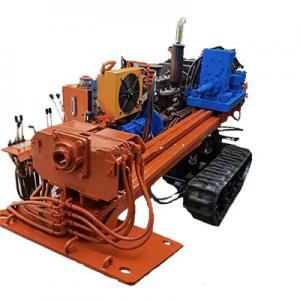

Add to Cart
Remote Control Water Injection System HDD Drilling Rig 62kw Thunder Power
Product Description
A small directional drill is a special construction equipment that can be used to lay underground pipes, cables and other public facilities without damaging the surface. It is suitable for working environment temperatures between -15°C and +45°C.
Horizontal directional drilling technology is a new technology that combines the directional drilling technology of the petroleum industry and traditional pipeline construction methods. This technology has the advantages of fast construction speed, high construction accuracy and low cost. Horizontal directional drilling equipment continues to develop, and ultra-depth guidance and monitoring technology is also widely used. This equipment is usually suitable for laying steel pipes and PE pipes with a length of about 300 meters, and the maximum pipe laying length can reach 200m. It is suitable for various soil conditions, can be constructed from soft soil to hard rock, and has broad application prospects.
Technical Parameters
| Model | RCHD-160 |
| Rig weight | 2.2t |
| Dimensions (L×W×H) | 3700*1800*1200mm |
| Engine power | 62kw Thunder Power |
| Max. push & pull force | 160KN/16T |
| Traveling form | remote control |
| Walking speed | 2km/h |
| Water injection system | 160 type three-cylinder mud pump |
| Max. pressure of mud pump | 2.8MPa |
| Max. flow of mud pump | 160L/min |
| Entry angle | 28° |
| Departure angle | 20° |
| Climbing ability | 35° |
| Torque | 3200N.m |
Application
It is widely used in the laying of pipelines for water supply, electricity, telecommunications, natural gas, coal gas, oil, etc. It is suitable for various geological conditions and is especially good at processing sand, clay, pebbles and other strata. Traditional excavation methods can encounter difficulties in these conditions, but directional drills can complete construction tasks more efficiently and safely.
In sandy soil strata, directional drilling rigs reduce the impact of excavation on the environment, avoid ground settlement and damage, and can drill passages underground without the need to excavate the entire route, saving time and costs.
In clay strata, directional drilling rigs can easily pass through sticky soil, reducing construction difficulties caused by soil adhesion. By rotating the drill bit and spraying mud to soften and remove the soil, the pipe can be laid smoothly.
In strata such as pebbles, directional drilling rigs use strong thrust and torque to penetrate hard strata to lay pipes. Its traversing capabilities make it ideal for handling these types of geological conditions.
Machine picture display
